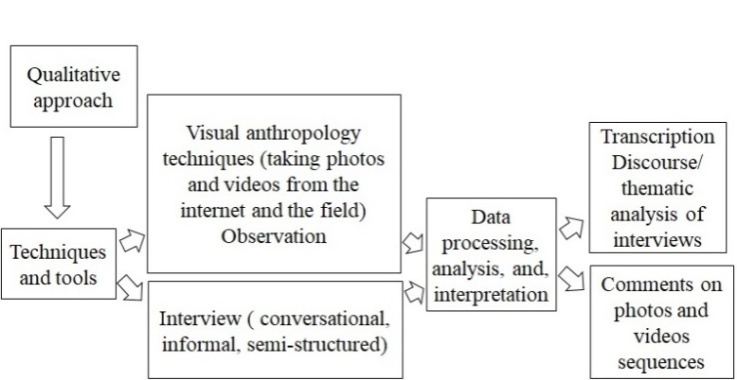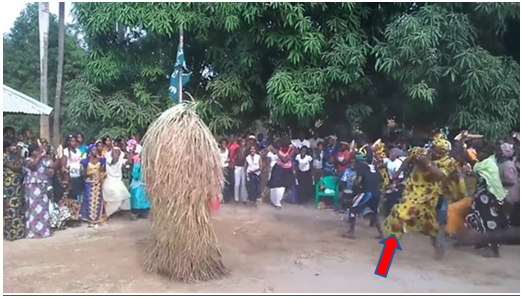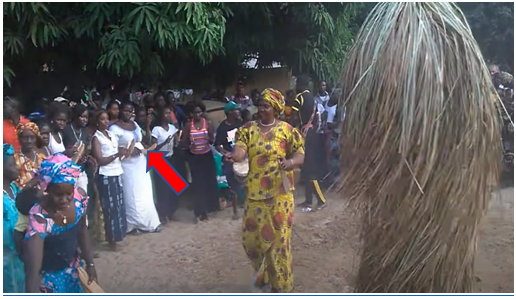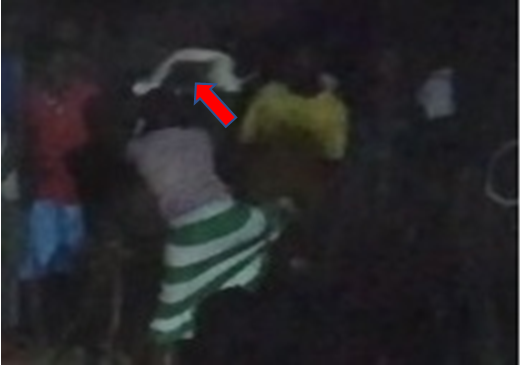-
Paper Information
- Paper Submission
-
Journal Information
- About This Journal
- Editorial Board
- Current Issue
- Archive
- Author Guidelines
- Contact Us
American Journal of Sociological Research
p-ISSN: 2166-5443 e-ISSN: 2166-5451
2022; 12(1): 10-18
doi:10.5923/j.sociology.20221201.02
Received: Apr. 21, 2022; Accepted: May 16, 2022; Published: May 24, 2022

Preventing Non-Communicable Diseases Through Cultural Dance in Africa: The Example of kúmpo’s Dance Among the Diola Communities of Lower Casamance in Senegal
Ina Maimouna Mengué Badji1, Cheikh Ibrahima Niang1, Pascal Assine2
1Institute of Environmental Sciences, Cheikh Anta Diop University, Dakar, Senegal
2Department of Linguistic, Cheikh Anta Diop University, Dakar, Senegal
Correspondence to: Ina Maimouna Mengué Badji, Institute of Environmental Sciences, Cheikh Anta Diop University, Dakar, Senegal.
| Email: |  |
Copyright © 2022 The Author(s). Published by Scientific & Academic Publishing.
This work is licensed under the Creative Commons Attribution International License (CC BY).
http://creativecommons.org/licenses/by/4.0/

Cultural dance is recognized as a therapy that supports the physical, social, and mental well-being of communities in Africa. This paper analyses the relationship between the representations, practices and attitudes surrounding the diola cultural dance and the prevention of non-communicable diseases risk factors among diola communities of Lower Casamance. A qualitative approach is used for the study with techniques and data collection tools as literature review, interviews, observation, photos and videos elicitation. Interviews transcribed, descriptions and comments of photos and videos are the main data processing and analysis enabled lexical field identification and significations around kúmpo cultural dance associated to psychological stability preservation. Idioms, concepts, and interpretation of expressions in diola fogny language, transcribed and translated in English highlights representations on the body linked to physical activity as a means of preventing non-communicable diseases that can be mobilized for prevention strategies in communities.
Keywords: Cultural dance, Prevention, Non-communicable diseases, Lower Casamance, Senegal
Cite this paper: Ina Maimouna Mengué Badji, Cheikh Ibrahima Niang, Pascal Assine, Preventing Non-Communicable Diseases Through Cultural Dance in Africa: The Example of kúmpo’s Dance Among the Diola Communities of Lower Casamance in Senegal, American Journal of Sociological Research, Vol. 12 No. 1, 2022, pp. 10-18. doi: 10.5923/j.sociology.20221201.02.
Article Outline
1. Introduction
- Non-communicable diseases (NCDs) are a global public health challenge. According to Laura Pryor, Azevedo Da Silva, and Maria Melichor (2017), these diseases are one of the leading causes of death in the world. Among them, four groups as cardiovascular diseases (17.9 million deaths per year), chronic respiratory diseases (3.9 million), diabetes (1.6 million), and cancers (9.0 million) are responsible for nearly 80% of premature deaths globally (Bigna & Noubiap, 2019). In Sub-Saharan Africa, there is an increase in NCDs in addition to the burden of infectious diseases such as HIV and tuberculosis (Sharman & Bachmann, 2019). NCDs are linked to some behavioral and modifiable risk factors such as physical inactivity (Ekpenyong et al., 2012; Milton et al., 2014; Hanif et al., 2021). Increasingly, physical inactivity becoming a health issue that “causes 6% of the burden of disease from coronary heart disease, 7% of type 2 diabetes, 10% of breast cancer, 10% of colon cancer, and, almost 9% of premature deaths globally” (Lee et al., 2012). In Sub-Sahara Africa (SSA), physical inactivity contributes to the burden of NCDs. The prevalence of physical inactivity is respectively “estimated to be 58.84% in Ivory Coast and 69.81% among heart failure patients in Senegal (Ahouéfa et al., 2021; Affangla et al., 2019). A high prevalence of physical inactivity (19,2%) was reported among adults in Nigeria” (Aliyu et al., 2015).In response to health issues such as physical inactivity, dance (cultural dance specifically) is used in the biomedical field as a therapy against cancer and chronic respiratory diseases, but also, for preventing obesity, depression, stress, and anxiety, with benefits in terms of psychological, psychic, emotional and social well-being (Aktas & Ogce 2005; Muller-Pinget et al., 2012; Philip et al., 2020, Hanna, 2007; Sedibe, 2014; Conner et al., 2021). Social sciences research highlights the socio-cultural function of dance in Africa. In this context, dance is involved in building cohesion, resolving conflicts, “managing psychological and social tensions” (Evans-Pritchard, 1928: 459; Hanna & Hanna, 1971:238). Similarly, dance is seen as a cultural practice whose purpose is to strengthen social bonds between transnational communities and their family, and “solve family conflicts” in Senegalese communities (Kringelbach, 2013: 30; Canon, 2005). However, despite the importance of cultural dance in the management of biomedical and social health issues, few studies have focused on the analysis of the relationship between socio-cultural function of cultural dance and NCDs prevention in Africa. Specifically, this work aims to analyze how dance, as a cultural aspect, can contribute to preventing NCDs, but also constitutes a community response to health issues in the African context, particularly in the communities of Lower Casamance in Senegal. The paper is structured as follows: the research approach, which addresses the design and implementation process that led to the expected results; the results, which highlight the established relationship between cultural dance practice and the prevention of NCDs risk factors; the discussion of the results; and the conclusion.
2. Methods
- For this work, the qualitative approach is used. It is the implementation of the reasoning that led to the expected results through the collection, processing, analysis, and interpretation of data as shown in the following figure.
 | Figure 1. Approach, techniques, data processing, analysis and interpretation (Source: Authors (2022).) |
2.1. Sites and Population
- This work is a case study in which the target population consists of key informants, and social strata originating from the Lower Casamance region who share the diola fogny language. Region in southwestern Senegal, the Lower Casamance is characterized by cultural originality. The Diola (57.8%) constitute the majority ethnic group in this area (ANSD, 2018; Thomas, 1968), and are subdivided into sub-groups that identify with a language. Thus, there are, among others, the Diola Fogny, (Diatta et al., 2020) to whom, like other ethnic groups, certain practices such as the mask dance are attributed.This population lives mainly in some municipalities, neighborhoods, and villages that are administratively attached to the regions of Dakar, Ziguinchor, and Kedougou. The population concerned by the data collection consists of members of Diola community associations from Lower Casamance, who have knowledge of culture and are involved in the socio-cultural activities of their village where they are originated from. These members include the elderly (60 years old and over), academics, and some members of youth organizations with a special status (presidents of cultural and sports associations), NCDs patients, etc. In addition, the data collection covered all social strata likely to be affected by NCDs risk factors. A sample of 17 participants is determined by saturation during data collection when interviews with communities on dance address similar themes. The sites and populations are purposedly chosen.
2.2. Techniques and Tools
2.2.1. The literature Review
- The literature review was useful for assessing the state of knowledge on the NCDs’ risk factors regarding cultural dance. Articles, books, theses, study reports, etc. related to the subject were consulted in some libraries of Cheikh Anta Diop University of Dakar, and also the websites of scientific journals in the following fields: biomedical, socio-anthropological, environmental sciences, public health (The Lancet, American Journal of Dance Therapy, Social Science & Medicine, PLOS ONE, etc.).
2.2.2. Observation
- Observation allows us to describe the physical and socio-cultural frame in which the inter-individual and collective interactions that highlight the relationship between communities and their environment during the dance of kúmpo, a diola’s mask made of 'ronier' tree fibers which cover the dancer (Mark 1983). It is a figure dressed in straw with a stick protruding from the top of its head that spins round and round and is the center of the dance: " kaboomen ekúmpaay" (Sapir et al., 1993).
2.2.3. Video and Photography
- Visual techniques and tools are used for secondary data collection on the internet and in the field. These techniques “allow reflection on people’s practices, values, interests, and symbolic discourse” (Alfonso et al., 2004). Images that are obtained with photography and videos highlighted some recurrent practices and actions identified during the dance that may be directly and indirectly related to the prevention of NCDs risk factors. The videos and photos were obtained in the field with the people’s consent.
2.2.4. The Interview
- Prior to that, once a relationship of trust has been established, materials (photos and video sequences) are shared (by phone or in the field) with individuals in the communities where interviews were run. In the same way as the socio-constructivist model (Crewell, 2013: 25), exchanges through interview guides focused on the meanings of some practices, individual and collective gestures, their experience, their feeling to understand their representation, their emotion, the codes of conduct, the meaning given to actions as well as the symbolism around the dance. Similarly, the conversational interview with informants facilitated the comprehension of a number of cultural concepts. The lexical field of cultural dance is provided. The aim is to find the meaning of key terms in the diola fogny language that refers to socio-cultural constructs on solidarity, peace culture, social cohesion, life preservation, health maintenance, and NCDs risk factors prevention. is a case study in which the target population consists of key informants, and social strata originating from the Lower Casamance region.
2.3. Data Processing and Analysis
- The use of visual techniques generated images (photos) as material obtained with the photography on the field and capture of specific actions contained in videos (actions chosen according to their observed recurrence). From the research validation perspective, these images are described, discussed, and commented on with the key informants and the communities in general. Key concepts and terms used by the communities to describe their practices, behaviors, and attitudes associated with dance are decoded after the transcription and translation of interviews that were subject to thematic and discursive analysis.
3. Results and Discussion
3.1. The Role of Kúmpo in Social Stability Associated with the Prevention of NCDs Risk Factors
- One of functions of the kúmpo is to regulate social life by taking charge of the education of young people. In other words, the role of the kúmpo is re-establishing social order in situations where a young person does not respect social norms. According to a key informant: “If a child commits a mistake, all the family is not in peace. The kúmpo takes care of his education.” The lack of peace and tranquility expressed in these words reflects a social condition characterized by anxiety of those around them when a child or family member breaks a pre-established social norm. It is as if the “kúmpo” relieves the family from a burden caused by the behavior of a member. The kúmpo’s dance can therefore be considered as a form of social regulation that aims at preventing anxiety and stress in communities. Consequently, the educational function of the kúmpo is inevitably associated with anxiety prevention. Therefore, African dance can prevent future heart disease by alleviating stress in communities in Africa (Conner et al., 2019).The kúmpo’s dance plays an important socio-cultural role in the Diola’s culture. One of its roles is to prevent the stress that could result from the feeling of insecurity linked to the social imbalance that manifests itself in situations of conflict, epidemic, famine, etc. that have mystical aspects. Referring to the mystical character of the kúmpo, an informant said: “He doesn't go out anyhow. The village may be in a period of famine. There are negative forces in the village that prevent people from having a good harvest. The kúmpo goes out to see how he can find a solution for the village.” It seems as if the kúmpo raises the hope of social order or contributes to the restoration of social links, reconciliation, and social peace, which will ensure the well-being of the communities. This belief can be found in some of the songs during the dance sessions:“A word has been spoken: let us forget it.Forgive usWe will dance this world todayDiénebe invites the kúmpo saro” (Girard, 1969: 338).Through this song, one gets the impression that one of the social functions of the kúmpo lies in the settling of disputes and misunderstandings that favors the establishment of reconciliation conditions for peace and tranquility in the community. Socio-cultural activities as the dance of kúmpo, reflect community constructions around peace, happiness, and the preservation of health. Consequently, the example of the kúmpo’s dance is an indication of the sense of solving social issues (health issues in particular) peacefully in African societies. This enables the restoration of social balance characterized by the search for pleasure and/or happiness of the community, in order to relieve tensions that could affect negatively communities' health.The communities of Lower Casamance, as elsewhere in Africa, carry out cultural practices linked to preventing and managing health issues caused by conflicts situations, tensions, stress, anxiety, etc. Socio-cultural activities such as the kúmpo’s dance appear as a form of reproduction of the construction of philosophy around peace and reconciliation in Africa. Also, the “Lamokowang dance addresses the community challenges of reconciliation and socio-cultural reintegration in a post-conflict context in Uganda” (Karoblis et al., 2020). Social life is thus marked by mystical practices necessary to maintain cohesion and psycho-social stability. Resorting to mysticism could therefore be seen as a form of response construction to social crises that are often at the origin of anxiety and stress in communities. Anxiety and stress have been identified as risk factors associated with NCDs (Liu et al., 2021).Women play an important role in creating joy and happiness during the event. The figure below illustrates the manifestations of satisfaction of participants after kúmpo’s, performance due to women’s applause.
 | Figure 2. Jubilies and burst of joy (indicated by red arrow) aroud the kúmpo after his performance (Source: https://www.youtube.com/watch?v=A-k8t3eFyA0) |
3.2. Dance as an Expression of Women’s Role in Solidarity Building Related to NCDs Prevention
- Dance, translated by the term jíboom, in the diola fogny is an activity during which social interactions are observed both between the communities themselves and between the kúmpo and the participants. In other words, some practices are associated with social solidarity seen as an important aspect in the preservation of social cohesion. The dance highlights the importance of women’s role in socio-cultural events. In the same way that they take charge of the majority of social life activities related to the well-being and survival of the family, the whole community, particularly women are also at the “heart” of dance. This appears through songs and applause of the women who produce the sound that sets the rhythm of the dance for both the kúmpo and participants. Applaud refers to the diola fogny expression leew, which is emphatically expressed by the participants to encourage the dancer.
 | Figure 3. Women applaud the Kumpo (Source: https://www.youtube.com/watch?v=A-k8t3eFyA0) |
3.3. Building Happiness and Preventing NCDs Risk Factors
- The kúmpo’s dance is punctuated by actions and interactions that refer to the expression of a shared feeling of happiness. The performance of the central figure of the kúmpo is sanctioned by shouts of joy, jubilations that consist in paying tribute to him, showing satisfaction. In this regard, one interviewee who commented on the reaction of spectators said: “If people don't do it (shout, shout for joy), it means that the kúmpo is not up to the challenge.” The performance of the kúmpo then brings a sense of joy to those around him and should in principle be rewarded to achieve social balance.The shouting and jubilees can be seen as a shared therapy between dancers and spectators. Those who are present but do not dance play an important role in motivating and encouraging the dancers through shouts. The spectators’ appreciative roar of joy for the beauty of the performance is also noticeable. They take pleasure in attending the event, which gives them a feeling of happiness. The roar is an expression of pleasure, happiness but also of relief. Thus, the roar can take the form of a spontaneous outburst that demonstrates the satisfaction, the relief of the spectator during the dance. Spectators also play an important role in community mobilization for the dance. In fact, according to one informant: “the screams are loud. They can be heard from far away.” This generates curiosity among residents who express their desire through these words in diola fogny: (u)jaal ujukaal which means “let's go and see” in English. This implies the desire to attend the show but also to dance according to the situation, as the following passage shows:Once, we were attracted by a dance from a distance. We were revising our lessons and all of a sudden, we heard shouts that made us want to go and see what was going on. Then we did everything we could to get there. When we arrived, we came across a man who was dancing. He was dancing with a harmony that ended with a spectacular action that made people shout. (...) ukámunaaw wu súnsuum (literally the feet are good. This conveys the idea that he has mastered the art of dance).Thus, the participants shout at the beauty of the dancer’s performance. This also highlights the aesthetic dimension of the dance, which gives pleasure. Dance appears here as an art whose harmonious gestures bring pleasure and joy to spectators. Moreover, according to Thomas (1959: 353), “the diola dancer is the true artist who creates a fusion with the group, a state of mind which is already true depersonalization.” Dancing is therefore an activity marked by the expression of shared happiness. The kúmpo’s dance is an event in which the expression of shared happiness within the community is observed. The search for happiness and pleasure through the interactions between dancers and participants promotes the strengthening of social bonds, solidarity, and the establishment of conditions associated with NCDs management. In the same way, results from research show the role of happiness in the prevention of NCDs in Bhutan, South East Asia. Indeed, the risk factors for NCDs are found in a context marked by a lack of education and practical knowledge about NCDs prevention. Yet in this community, “finding happiness in any situation is a virtue” (Kohori-Segawa et al., 2020).
3.4. Reproduction of the Concept of Accountability, Social Empowerment and NCDs Prevention
- The dance is marked by declamations of words, phrases, or concepts. Some do not hesitate to invite the audience to clap their hands louder with words like jileew (clap your hands) to further encourage the dancers. It is as if the dance is a moment of sharing in which every action taken by an individual requires a response from the participants. The lack of response can be interpreted as a lack of interest in the invitation to dance, to share moments of joy. This attitude can be seen as a refusal to respond favorably to the honor shown by those around them.Dancing is also an activity during which social values associated with accountability, honor towards loved ones often carried by women during the event are observed. Indeed, in some of the videos or photos, actions that consist in throwing the scarf at a third person (parents and others) are seen.
 | Figure 4. Women dancing and send the scarf to another (Source: Authors (2022).) |
 | Figure 5. kafikis action of a dancer (Source: Authors (2022).) |
3.5. Dance and Representation of the Body Associated with NCDs
- Dance is also associated with representations on relationship with the body. This relationship is encapsulated in concepts uttered during the activity and shows how communities mobilize themselves to carry out the event. In addition to songs accompanied by applause to set the rhythm of the dance, the communities often use the diola fogny term goroor which also refers to the action of sketching dance steps. Indeed, the expression means, “to shake the body”. Dancing, through the expression goroor: “to shake the body” could be considered here as a physical activity that allows the prevention of some pathologies such as NCDs. Moreover, one informant, who suffers from diabetes, recommends people to “move” for preventing diseases associated with sugar excess consumption. She said: “You eat a lot, you finish eating what you like, the sweet stuff, and then you don't move around, and people should be careful about that.”The fact of moving is associated with physical activity that could prevent chronic diseases such as diabetes. This aspect is taken into account (apart from conventional physical activity or practiced according to the Western model such as walking, running, fitness, etc.) by the kúmpo’s dance. Beyond the mystical, folkloric, playful character, etc., the kúmpo’s dance is an opportunity for some people to move, to practice physical activity. This is the case of one interviewee who referred to the kúmpo dance and said: “Sometimes if you sit here, you can hear the young people over their dancing. You can walk over there. If you arrive and shake your body a bit.” As a result, communities have, by increasing interest in physical activity (Conner et al., 2019), developed socio-cultural activities such as dance that directly or indirectly contribute to the management of health issues such as non-communicable diseases (Yamasaki et al., 2021). In addition, dance appears, in this context as African holistic health because it takes into account the whole aspects of the disease: body, mind, and spirit (Ubani, 2011) that can be associated with NCDs prevention.
4. Conclusions
- Cultural dance among the Diola communities of Lower Casamance, appears to be one example, among many others, of a community resilience strategy in facing NCDs issues in Africa. However, with the phenomenon of globalization, which is accompanied by changes in lifestyle, we are increasingly witnessing the decline or even disappearance of cultural practices such as cultural dance. The responses to NCDs’ health issues must take into account and mobilize the cultural capital of communities. Therefore, communities’ responses can include the organization of dance activities over a given period, supported by the local authorities (village chief and/or traditional leader). The cultural dimension of dance could particularly be integrated into the discussions during meetings and exchanges in decision-making fora. For this to happen, the mobilization of resources at the community level is more than needed. It is a question of giving priority to and reflecting on forms of motivation for local artists (drummers in villages or ekontiŋ players in the Kassa environment: ekontiŋ is an instrument, a three-string guitar made from a calabash).The Lower Casamance communities living in other parts of the country could, through the organization of cultural events, influence behavioral changes towards the promotion of physical activity (through dance) and the creation of a social climate that can foster stronger ties and social cohesion. In addition, it would create conditions that are closer to the socio-cultural realities of the communities, but also a means of transmitting to future generations the cultural values of the group associated with the prevention of health issues, particularly the risk factors for NCDs.
ACKNOWLEDGEMENTS
- The authors acknowledge:Yacinthe Sambou, Teacher and Researcher, Institute of Environmental Sciences, Cheikh Anta Diop University;Lamine Bodian, Lecturer, Department of Linguistic, Cheikh Anta Diop University;Dr. Papa Waly Bakhoum, Institute of Environmental Sciences, Cheikh Anta Diop University and;MS. Mamadou Lamine Sané, Institute of Environmental Sciences, Cheikh Anta Diop University, for technical assistance and proofreading.
 Abstract
Abstract Reference
Reference Full-Text PDF
Full-Text PDF Full-text HTML
Full-text HTML